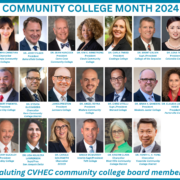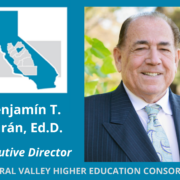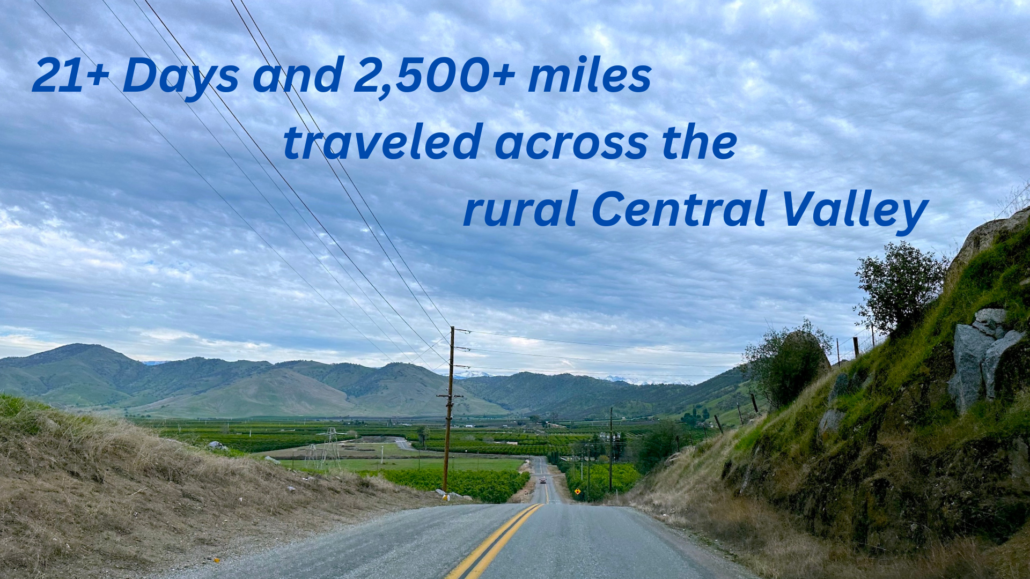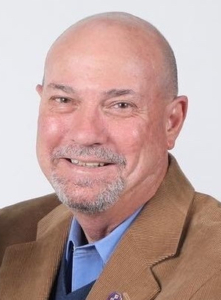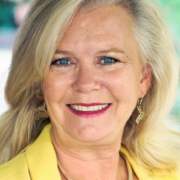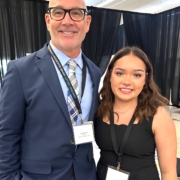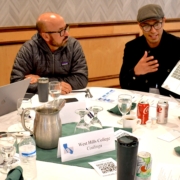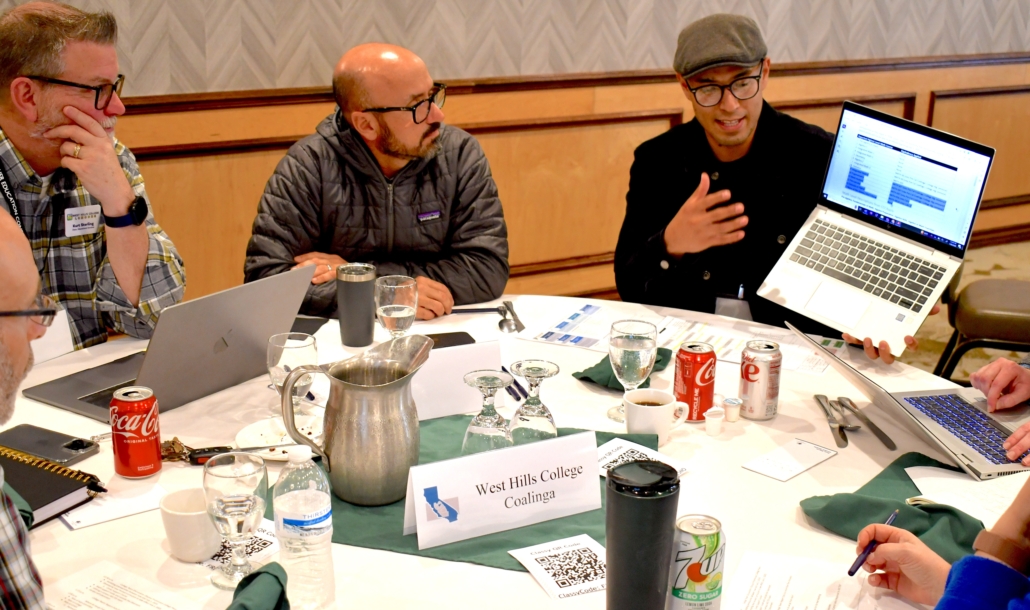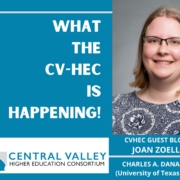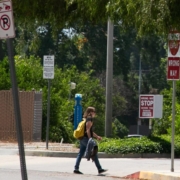CVHEC DIRECTOR’S MESSAGE (April 2024): The math mission!
A mission of math continues in the Central Valley
Greetings CVHEC friends and colleagues!
Welcome to our April newsletter as we are a month or so to closing out another academic year in the Central Valley. We are particularly pleased to shine a spotlight on our community college board members for National Community College Month. Our Central Valley community college leaders are dedicated to serving our students with great pride.
You will note that this issue focuses on mathematics education activity in the Central Valley. Our CVHEC partners — College Bridge and the Charles A. Dana Center from the University of Texas at Austin — have been working with our regional partner community colleges and high schools to build pathways and eliminate barriers for our students looking to navigate the challenge of completing their gateway courses in college math.
You will get a glimpse of the work that the Central Valley Math Task Force members will be undertaking at their April 19 convening. Also, an update by Dr. Nicole Korgie highlights the progress College Bridge has made with implementing the Math Bridge project to enroll high school students in college level dual enrollment classes.
But our big news on the math mission front is the awarding of two grants to CVHEC from the Regional K-16 Education Collaboratives Grant Programs by the WE Will! K-16 Collaborative that will expand our Math Bridge and Master’s Upskilling projects into the north valley. Congrats CVHEC-members: University of California, Merced (WE Will’s lead agency); Merced College; Modesto Junior College; San Joaquin Delta College; and California State University, Stanislaus for your leadership.
And in our News section, we welcome new presidents to two of our CVHEC member institutions:
- Britt Rios-Ellis was named by the California State University Board of Trustees as the new president at CSU Stanislaus effective July 1.
- Dr. Rafe E. Trickey will begin his tenure as superintendent/president of Taft College May 3 after his appointment by the West Kern Community College District.
We look forward to having President-select Rios-Ellis and President-select Trickey join us on the CVHEC Board of Directors.
Thank you all, I hope you enjoy this April issue.
MATH BRIDGE UPDATE- April 2024
The road to Orosi, California typifies the rich rural areas of Central California where CVHEC and College Bridge are reaching
out to provide Math Bridge services that help prepare high school students for college. (Tom Uribes photo)
Math Bridge campaign identifies nearly
1,000 students for college-level math courses
BY DR. NICOLE KORGIE
Vice President of Operations – College Bridge
The Central Valley Math Bridge project is off and running as 13 committed high school partners with College Bridge and the Central Valley Higher Education Consortium are completing a student recruitment campaign that has identified nearly 1,000 students ready to take on college math and nearly half of those indicating their interest to participate.
The impact Math Bridge is having on education in the region is seen in one general characteristic of these students: they were likely NOT to have taken an advanced math course, or even math at all, in their senior year.
Now, as more high school students graduate with solid/advanced math skills though Math Bridge, more students will find success in college and career, filling vital local workforce needs.
The participating high schools stretching across the Valley’s nine-county region from Taft to Stockton are partnering with six community college members of CVHEC to offer the math dual enrollment courses at their respective campuses beginning next fall (student breakdown in parenthesis. The community colleges and their participating feeder schools are::
DELTA COLLEGE: Stagg High School, Weber Academy;
MERCED COLLEGE: Atwater High, Buhach Colony High School, Golden Valley High School, Livingston High School, Mariposa High School;
REEDLEY COLLEGE: Dinuba High School, Orosi High School, Sanger High School, Sanger West High School;
TAFT COLLEGE: Taft High School;
WEST HILLS COLLEGE LEMOORE: Riverdale High School.
The campaign: no longer running from math!
The nearly 1,000 Central Valley students from these high schools identified as great prospects to participate in Math Bridge have solid academic GPA’s — between 2.3 – 3.4 — but have struggled in high school math.
Beginning at Taft High School in January, the prospective students were presented with information about Math Bridge and the benefits of participating such as allowing these students to complete a college level math course before they graduate from high school.
While you may think that many if not all students who fear or dislike math would run screaming if presented with the opportunity to take a college level math course, you may now re-think that: of the nearly 1,000 students identified, NEARLY HALF completed a form AFFIRMING their interest in participating in Math Bridge. They expressed a desire to take on the challenge of college level math that the Math Bridge project provides the high school including extensive support to help students pass the course.
For the upcoming academic year, all Math Bridge partner sites will offer a statistics course though their local community college. Math Bridge will be working with the college faculty and high school math teacher at each site to ensure that appropriate support services are provided to the students in the course.
We are currently following up with the 500 students who completed the interest form in the recruitment sessions to ensure that they meet with their school counselor to confirm that Math Bridge is the correct option for them for senior year and their post-secondary goals.
To date, 230 students have signed up. And we’re not done yet as Dinuba and Stagg have yet to begin their student recruitment process so even more students will be given this opportunity by the time we provide a final enrollment number in a future update.
Prepping participant high schools for Math Bridge
As this student recruitment campaign wraps up this spring, we now move into the support phase for the educators from the high school participants with a special event May 3 in Fresno to help prepare teachers for the Math Bridge project’s launch in the fall semester.
On that day, College Bridge will host our Math Bridge Instructional Planning Meeting where college and high school math instructors and their support teams (math coaches, chairs, supporting faculty) will collaborate with our project team around the who, how, when, where and what for the Math Bridge courses to be taught in Academic Year 2024-2025.
Activities for the day will include reviewing curriculum, assessments and commonalities between college courses and any necessary local differences. We will also review the requirements for instructors to earn the project stipend as well as calendaring all future planning and collaboration times per college service area.
It is understandable that some feel the slight mention of math is enough to squash any conversation but the groundbreaking role these Central Valley high schools and their community college partners are taking on with College Bridge and CVHEC is a new level of excitement for educators seeking to arm their students for a successful higher education experience.
BACKGROUND: College Bridge’s mission is to identify and eliminate barriers that prevent underrepresented students from progressing to and through college specifically focusing on Black, Latino, low-income and rural students. One of its two objectives is to expand strategic dual enrollment partnerships to serve low-income, rural and Latino students in California’s Central Valley. In December 2022, College Bridge was awarded a five-year $4 million US Department of Education grant for the Dual Enrollment Math Bridge Project so six CVHEC community colleges could provide college-level math classes that will improve and support college readiness for underprepared students in the colleges’ respective service areas. In April 2023, the project received a $1,075,340 award from the California Regional K-16 Education Collaboratives Grant Program through two Central Valley K-16 programs – the Fresno-Madera K-16 Collaborative and the Tulare-Kings College & Career Collaborative. Then in December 2023, a $2,196,928 federal grant was awarded for expansion of the College Transition Bridge project that, among other features, will advance collaboration with CVHEC’s Central Valley Transfer Project and its college course-planning software, Program Pathway Mapper, as well as with consortium member colleges.
CVHEC BOARD NEWS: Dr. Rafe E. Trickey named Taft College president
The West Kern Community College District (WKCCD) Board of Trustees has selected Dr. Rafe Edward Trickey, Jr. to become the next superintendent/president of Taft College.
He will replace Superintendent/President Brock McMurray who is retiring after 23-plus years with the district. McMurray has served as superintendent/president since July 2022.
The board intends to approve an employment agreement at the next regular meeting scheduled for Wednesday, April 10, 2024, with a start date to follow on June 3, 2024 when he will also become a member of the Central Valley Higher Education Consortium Board of Directors made up of the heads of 28 institutions of higher education in the nine-county region.
The selection was made following a nationwide search, coordinated by Community College Search Services, that produced a strong pool of well-qualified applicants for the position.
A diverse search committee of campus and community members narrowed the list of applicants down to five finalists who presented at public forums on March 21 and interviewed with the Board of Trustees on March 22.
Taft College Board President Billy White stated, “On behalf of the Taft College Board of Trustees, I would like to extend a warm welcome to Dr. Rafe Edward Trickey, Jr. as our next Taft College superintendent/president. Dr. Trickey brings certain depth and breadth of experience and knowledge to the college in a time of transition and great opportunity.
We sincerely thank the search committee and Taft community members for their valuable time and input during this process. Please join the Taft College Board of Trustees in congratulating Dr. Trickey on his new role!”
About Dr. Trickey
Dr. Rafe Edward Trickey, Jr. currently serves as president and chief executive officer of the North San Diego County Promise, a San Diego County inclusive collective-impact partnership that is united by a shared vision of all youth and adults reaching their fullest potential in grade school, college, career and life. The North San Diego County Promise strategically and efficiently aligns programs, services and resources to improve the social, emotional, academic and life success of service community members. The North San Diego County Promise’s intentionally collaborative, equity-focused, and data-informed work is concentrated on inclusionary systems change and ensuring marginalized communities have equitable access to educational, economic, and life opportunities.
Dr. Trickey is an experienced, empowering, courageous, visionary, equity-minded, and success-focused leader, who has enjoyed an extensive career in education, public-benefit corporations, and public service. He maintains that creating success pathways, empowering people, and expanding equitable access are very important. For over four decades, he has championed the maxim that when some among us are not succeeding, none of us is really succeeding. He has served as President of Comanche Nation College, an open-access, community/tribal college in Oklahoma, as President and Chief Executive Officer of Sisseton Wahpeton College, an open-access, community/tribal college in South Dakota, as Vice President of Student Services and Vice President of Planning and Institutional Development at the College of the Marshall Islands, an open-access, public community college in the Marshall Islands, as Executive Director of Development and External Relations at Citrus College, a California Community College, as President and Chief Executive Officer of the California-wide CHP 11-99 Foundation, and as City Treasurer in the City of Oceanside, California. Among multiple community member success supporting volunteer leadership tenures, Dr. Trickey has served as a Housing Commissioner in the City of Oceanside, as a Co-chair of the Alliance for Regional Solutions’ Racial Justice Committee, as Board of Directors Treasurer with Break the Silence Against Domestic Violence, as a Leadership Mentor and Advisor with Operation HOPE-North County, and as Board of Directors Treasurer with the Oceanside Promise.
Over the course of his leadership career, Dr. Trickey has cultivated a robust record specializing in student success, innovation, and mobilizing resources to improve educational outcomes and life opportunities. During his leadership tenures, the institutions he has served have secured new resources and realized measurable improvements in service population success. He maintains particular research and service commitments on utilizing a collective impact framework to guide collaboration focused on systems change, promoting and mentoring more women into top leadership positions (including superintendent positions, chancellorships, presidencies, executive directorships and public office), and the impacts evaluator attitudes, the role congruity biases many people consciously and unconsciously maintain, and evaluation practices have on perceptions of leader efficacy and leader success and persistence. Dr. Trickey is also committed to closing opportunity gaps for students and creating and delivering success-support pathways to individuals experiencing housing and food insecurity, as well as developing and implementing programs that uplift indigenous and other underrepresented and disproportionately impacted students.
Dr. Trickey was the first in his family line to attend and graduate college. He holds a Doctorate in Educational Leadership degree from the University of California, San Diego, a Master of Science in Education degree from the University of Southern California, a Master of International Affairs degree from Columbia University in the City of New York, a Bachelor of Arts degree in Political Science and History from the University of California, Santa Barbara, an Associate of Arts degree in Behavioral and Social Sciences from Modesto Junior College, a Certificate in Fund Raising with a Specialization in the Institutional Development Process from the University of California, Los Angeles, and a California Community College Instructor Credential in Government, valid for life.
Upon accepting his new position, Dr. Trickey shared, “As a product of the Great Central Valley and a California Community College alumnus, I’m beyond delighted to begin service as Taft College’s next Superintendent/President!
I’m very eager to start engaging with colleagues and building impactful and enduring relationships with local businesses, industry, and school districts throughout Taft College’s expansive service community. I’m committed to work collaboratively for the benefit of the entire West Side, assure Taft College continues to provide state-of-the-art educational opportunities and world-class career training services, and maintain Taft College’s place as the jewel in the crown of this region.
I’m also energized about working with the dedicated members of the West Kern Community College District Board of Trustees and Taft College’s amazing faculty, staff, and fellow administrators to create success pathways, empower people, and expand equitable access. Doing so is important to me, because I believe we’re all in this together; when some among us are not succeeding, none of us is really succeeding.”
To learn more about the West Kern CCD and Taft College go to https://www.taftcollege.edu/.
About Taft College
Established in 1922, Taft College is one of the oldest California Community Colleges. Located in Western Kern County, Taft College provides continuous learning opportunities for over 6,000 students through more than 50 vocational and professional degrees, transfer programs, and certificates. These innovative programs are made available at a fraction of the cost of state and private colleges. Proud to transform the lives of highly diverse students and adult learners, Taft College delivers vital pathways to advanced education and enhanced employment. In 2022, Taft College proudly celebrated its centennial year of student success.
See:
CVHEC BOARD NEWS: Britt Rios-Ellis appointed Stanislaus State president
The California State University (CSU) Board of Trustees has appointed Britt Rios-Ellis to serve as president of California State University, Stanislaus July 1, 2024 when she will also become a member of the Central Valley Higher Education Consortium Board of Directors made up of the heads of 28 institutions of higher education in the nine-county region.
Rios-Ellis currently serves as provost and executive vice president of Academic Affairs at Oakland University (OU), a public research university in Rochester, Michigan.
“I am both honored and humbled to serve this outstanding University alongside the talented faculty, staff, administrators and students at Stanislaus State, and to be the first new president selected under the leadership of Chancellor Mildred García,” said Rios-Ellis.
“I am eager to get to know the Turlock and Stockton communities and work together to ensure that the positive impact of our students’ and the University’s overall success is felt profoundly throughout the region.”
Rios-Ellis will be the University’s 13th leader, succeeding Interim President Susan E. Borrego who has served in the role since the retirement of President Emerita Ellen Junn in summer 2023.
“On behalf of the Stan state community, I welcome Dr. Rios-Ellis,” Interim President Borrego said. “She will join a community of committed faculty, staff and students who are proud to be a part of such an amazing University.”
“Dr. Rios-Ellis is an inspirational, compassionate and mission-driven leader, guided by a commitment to inclusive excellence and student success,” said CSU Trustee Yammilette Rodriguez, chair of the Stanislaus State Presidential Search Committee. “Her wide-ranging experience, student-centered approach and commitment to broader community engagement make her the ideal candidate to lead Stanislaus State in its next exciting chapter.”
Since joining the Oakland University leadership team in 2021, Rios-Ellis has focused on student and faculty success efforts with a focus on equity, resulting in an 8% increase in retention of underrepresented students, as well as decreasing equity gaps in bottleneck courses, and time to graduation. At Oakland University, she has worked with faculty to increase research activity, with the OU Senate to strengthen shared governance, and with deans and faculty to establish new and needed academic programs. She also coordinated successful fundraising and budget realignment efforts for the university and led an initiative to secure OU’s Carnegie elective classification for Community Engagement.
In all, Rios-Ellis has led more than $59 million in student- and community-strengthening health and education-related efforts funded by the National Institutes of Health, U.S. Department of Agriculture, the U.S. Department of Education among other agencies, as well as in collaboration with industry partners to reinforce workforce pipelines.
This marks a return to the CSU system for Rios-Ellis. Prior to joining OU, she served as founding dean of the College of Health Sciences and Human Services at California State University, Monterey Bay (2014 to 2020), where she led fundraising and strategic planning efforts and co-founded the Master of Science Physician Assistant Program — the first of its kind in the CSU.
From 1994 to 2014, Rios-Ellis served as a faculty member in the Department of Health Science at California State University, Long Beach. During that time, she also served as founding director of CSULB’s Center for Latino Community Health, Evaluation and Leadership Training (2005 to 2015) in alliance with UnidosUS, where she worked to promote and advocate for the health, culture and well-being of diverse communities. She was recognized with a CSULB Outstanding Professor Award in 2013 for her significant impact on Latinx health research and education, and she was named Woman of the Year by the National Hispanic Business Women’s Association in 2010 and the Regional Hispanic Chamber of Commerce in 2009. Additionally, in 2008, she received the Sol Award from the Los Angeles County Office of HIV/AIDS Planning Prevention.
Rios-Ellis earned a bachelor’s degree in political science and Spanish, a master’s degree in health and fitness management and a Ph.D. in community health — all from the University of Oregon.
MEDIA INQUIRIES: Rosalee Rush 209.664.6780 or rbrush@csustan.edu
See:
HIGHER ED NEWS: OER/Zero-Cost Textbooks
 Valley campuses experiment with zero-cost and discounted textbooks
Valley campuses experiment with zero-cost and discounted textbooks
In the San Joaquin Valley, colleges are trying a variety of ways to reduce these costs. While some programs have eased the struggle, others may be more hassle than they’re worth, some students say.
This EdSource article focuses on the work of Lemoore College President James Preston, a CVHEC board member, and features alumna Hailee Guerra, now a Fresno State student, who first recounted her college experiences at the CVHEC Higher Education Summit in October in Fresno: [EdSource]
(NOTE: CVHEC will soon be announcing its OER Task Force and collaborative efforts between members led by President Preston).
Math Task Force resumes AB1705 curriculum planning April 19
‘Continuing the CVHEC Way
to AB 1705 Success’ – Part II
Math Task Force resumes AB1705 curriculum planning April 19 with
a look at chancellor options, adding high school principals voices to the convo
Many of the best math minds in the Central Valley will resume their Assembly Bill 1705 compliance deliberations April 19 for the latest Central Valley Higher Education Consortium (CVHEC) Math Task Force convening, “Continuing the CVHEC Way to AB 1705 Success – Part II” from 9 a.m. to 3 p.m. at the DoubleTree by Hilton Hotel Fresno Convention Center.
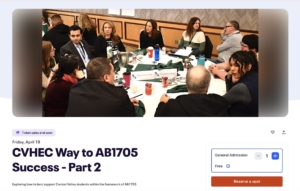 The agenda released last week includes a look at recent guidance from the California Community College Chancellors Office (CCCCO) and introduction of a new Principal’s Strand to the ongoing discussions as they work towards compliance with the final stage of AB1705 by July 1: validation of equitable placement, support and completion practices for STEM programs.
The agenda released last week includes a look at recent guidance from the California Community College Chancellors Office (CCCCO) and introduction of a new Principal’s Strand to the ongoing discussions as they work towards compliance with the final stage of AB1705 by July 1: validation of equitable placement, support and completion practices for STEM programs.
Participants are encouraged to register for the free event by the April 17 deadline said John Spevak, CVHEC regional coordinator who oversees the consortium’s Math Task Force.
About 85 community college math educators, administrators and institutional researchers are expected to re-convene for the day long CVHEC event co-facilitated by the Charles A. Dana Center (University of Texas at Austin), following up two virtual sessions in the fall and two in-person meetings.
This third in-person event on the topic is drawing many new faces with four principals and five other K-12 representatives registered to attend for input regarding what impact AB1705 will have at the high school level and how to work together to align math efforts.
Secondary education leaders registered to attend are:
- Lisa Castillo – Cutler-Orosi Joint Unified School District director
- Matt Gehrett – Dinuba Unified School District director
- Christine Johnson – Dinuba Unified School District math coach
- Celeste Azevedo – Mariposa County High School principal
- Marlena Celaya – Orosi High School principal
- Stasha Tiller – Riverdale High School principal
- Beu Her – Sanger High School deputy principal
- Christina Rubalcava – Stanislaus County Office of Education Math Project coordinator
- Brett Toliver – Stockton Unified School District principal
In addition to college administrators and institutional research participants, registration has also been received from representatives of the California State University Chancellors Office, the California Academic Partnership Program, the Fresno State Department of Curriculum & Instruction and the College Readiness Program, Citrus College (Glendora CA), MESA, STEM counselors and college articulation officers.
“Once again, this is an agenda which is engaging and interactive and enables the best math minds in the Central Valley to determine the best path forward to math success for Central Valley students in light of AB 1705 and in light of the recent memo from the Chancellor’s Office,” said Spevak, who is also a vice president-emeritus of Merced College.
He encouraged CVHEC community college members not yet involved to send a delegation of its math educators as well as administrators and institutional researchers to continue collaboration on curriculum discussion that would lead to fulfilling the last phase of the state law signed into law in 2022.
In what has been dubbed “the Central Valley Way,” the Math Task Force and convening participants have gathered to explore five strands of curriculum planning:
- Validating Prerequisites;
- Designing Precalculus for 2025;
- Math Support Outside and Inside the Classroom;
- Building an AB 1705 Campus Team; and
- Guided Self-Placement.
In a Dana Center analysis for CVHEC of the CCCCO memo issued Feb. 27 outlining options for the colleges to consider, Joan Zoellner noted that while the memo provides direction on the validation process for transfer level math placement and enrollment practices for STEM programs, it severely restricts the options for the number of transfer-level prerequisite courses that shall be offered prior to calculus.
“The options for that prerequisite course are limited by the memo and validation options as well”, said Zoellner, who is the Dana Center’s Launch Years Initiative lead.
Consortium community colleges were asked to review the chancellor’s office memo and some of the findings presented to determine how it affects their respective campus for discussion at the upcoming session including working with campus IR department to confirm the numbers and results prior to the April 19 convening.
To open the April 19 event, Spevak will be joined by Dana Center representatives Tammi Perez-Rice, Frank Savina, and Cassidy Kist in welcoming the participants.
Perez-Rice will provide of an overview of AB1705 and the Dana Center analysis of the CCCCO Memo sent to community colleges Feb. 27 to clarify and discuss options available for compliance. (See the What the CV-HEC is Happening Blog in this issue).
The group will then break out into these one-hour planning sessions:
- Option A planning – the Central Valley Calc 1 coreq
- Option D planning – the Central Valley Calc 1 prereq
- Options B and C – validating prerequisites
- High School Principals
Lynn Cevallos, College Bridge president, introduces a new Principals Strand which will feature high school leaders who currently work with the Central Valley Math Bridge Project.
“In our last session, at the behest of the only principal in attendance, Marlene Celaya of Orosi High, we realized the value of including K-12 voices at the table so we reached out to schools participating in our Math Bridge program with College Bridge,” Spevak said. “We appreciate the leadership of Marlene and Lynn Cevallos to expand our reach. We invite any other interested Central Valley K-12 officials to join us April 19.”
Following her session will be “Reports from Strand Leads:”
- NATHAN CAHOON, Taft College: Validating Prerequisites: Quantitative And Qualitative;
- JEREMY BRANDL, Fresno City College: Designing Precalculus for 2025 (designing calculus with support in 2025);
- Holistic Student Support
- MARIE BRULEY, Merced College: Building an AB 1705 Campus Team;
- JAY THOMAS, Lemoore College: Guided Self-placement and Registration Process;
- TINA AKERS, Modesto Junior College: Math Support Outside the Classroom —
Prior to the lunch break, Spevak will provide a preview of the afternoon breakout sessions which begins with follow up breakouts by strand.
For the final session of the day, college teams will meet to “Set Next Steps and Goals” under these topics: planning curriculum committee process; planning eval/validation; and planning how to set up registration process; and “Continuing the Central Valley Way — More than Just Compliance.”
In a closing 15-minute activity, college teams will each provide a report out.
“We appreciate the immense work by our regional community colleges in collaboration with CVHEC partners the Charles A. Dana Center from the University of Texas at Austin as well as College Bridge,” said Dr. Benjamín Durán, CVHEC executive director and president-emeritus of Merced College. “They are building pathways and eliminating barriers for our students looking to navigate the challenge of completing their gateway courses in college math.”
See:
AGENDA – The CVHEC Way to AB 1705 Success Part 2
WHAT THE CV-HEC IS HAPPENING BLOG (April 2024): AB1705 – Dana Center analysis of CCCCO memo
 This month’s “What The CV-HEC Is Happening” guest blog is presented by Joan Zoellner, M.A., Launch Years Initiative lead for the Charles A. Dana Center (University of Texas at Austin), co-facilitators of the CVHEC Math Task Force AB1705 Compliance Convenings held the past six months. She provides the task force with an analysis of the validation memo issued Feb. 27 by the California Community College Chancellor’s Office outlining options for community colleges to consider by a July 1 deadline. The memo and this analysis will be discussed at the upcoming MTF Convening April 19 in Fresno. The CVHEC blog features perspectives about the higher education community and issues. Submissions are welcome for consideration: Tom Uribes, cvheccommunications@mail.fresnostate.edu.
This month’s “What The CV-HEC Is Happening” guest blog is presented by Joan Zoellner, M.A., Launch Years Initiative lead for the Charles A. Dana Center (University of Texas at Austin), co-facilitators of the CVHEC Math Task Force AB1705 Compliance Convenings held the past six months. She provides the task force with an analysis of the validation memo issued Feb. 27 by the California Community College Chancellor’s Office outlining options for community colleges to consider by a July 1 deadline. The memo and this analysis will be discussed at the upcoming MTF Convening April 19 in Fresno. The CVHEC blog features perspectives about the higher education community and issues. Submissions are welcome for consideration: Tom Uribes, cvheccommunications@mail.fresnostate.edu.
AB1705 Memorandum and CVHEC plan
The Feb 27, 2024, memorandum from the CCCCO (California Community College Chancellors Office) about validating STEM calculus prerequisites will have an impact on the plan to develop the “Central Valley Way” of complying with AB1705. To that end, key takeaways from the memo are listed below, followed by a suggestion for both the content of the April 19 workshop and the prep work assigned to campuses in advance.
According to the memo, no more than one transfer-level prerequisite shall be offered prior to calculus. The options for that prerequisite course are limited by the memo and validation options as well.
As of Jul 1, 2024, the only students that institutions can require to enroll in a validated STEM calculus prerequisite are those who (a) intend to pursue a STEM degree, and (b) have a high school GPA below 2.6, or (c) did not pass high school trigonometry, precalculus, or calculus with a grade of C or better. All discussion below is only about these students.
Institutions will have four options to comply with AB1705 and must select one by July 1, 2024. The least likely option for schools that are part of CVHEC, based on prior meetings and discussions, is Option B. In order to choose Option B, schools must show that their current prerequisite course meets the three requirements laid out in the law: (1) Students are highly unlikely (less than 15% throughput) to succeed if placed directly into STEM calculus, (2) taking the prerequisite course increases the student’s likelihood of passing STEM calculus, and (3) taking the class improves the student’s persistence to and completion of calculus 2 (if required for their program). The RP group did not find any institutions that met all three criteria. However, the Dana Center suggests that institutions review the reports provided by the RP group and work with their IR departments to check the calculations and results with the institution’s data.
Option C is also not a likely path for most institutions, as it requires that institutions first show that the throughput rate for a single existing prerequisite and calculus 1 is at least 50% over a 2-year period. These schools are then allowed to offer the prerequisite through July 1, 2027, to show that the prerequisite (now as a stand-alone prerequisite as opposed to one component of a multi-course prerequisite sequence) meets the three requirements of the law. While this work aligns with the work of the “Validating prerequisites” strand, the options for validation are now precisely described and do not permit several of the strategies under consideration by this strand.
Options A and D both align more closely with the bulk of the work in the central valley.
Option A removes all prerequisites for Calculus 1 and allows institutions to require a corequisite support course of up to two credits. This effort could include parts of the work happening in the “Math support outside the classroom” and “Building an AB 1705 campus team” strands.
Option D allows institutions to devise a new single-semester, 4-credit prerequisite course (with a possible 2 units of corequisite support) for STEM calculus. This course can be offered through July 1, 2027, at which point institutions must show that it meets the three requirements of the law. This work aligns with that of the “Designing Precalculus for 2025” strand.
Unfortunately, none of the options allow for validation using a survey or other measures.
In preparing for the April 19 event, the Dana Center proposes the following pre-work for institutions:
- Institutions review the individualized report provided by the RP group. They then work with IR to repeat and confirm the calculations using local data.
- Institutions will work with IR to calculate the 2-year throughput of the highest STEM calculus prerequisite and calculus 1 over the course of 2 years. If this is at least 50%, Option C may be available.
The agenda for April 19 will include a discussion of the validation memo, having institutions to pick the Option they wish to pursue, confirm the data they will need to submit (options B and C), begin collaboratively designing a corequisite (option A), or continue designing a new prerequisite (Option D) course. The goal is to have several institutions using a similar prerequisite course to enable continuous improvement, trouble shooting, and (potentially) larger sample sizes for evaluating the three requirements before July 1, 2027. Similarly, while not needing to meet the three requirements for the corequisite, schools can work together to design, implement, and improve the corequisite to support student success.
See:
CCCCO Validation Memo (Feb. 27, 2024)
Math Task Force resumes AB1705 curriculum planning April 19
Something extraordinary is happening in math in California’s Central Valley

